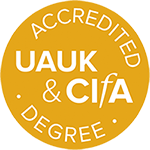The Als Archaeological Project: Stage Two
The second stage of the Als Archaeological Project is run by Dr M.L.S. Sørensen (Cambridge) in collaboration with Dr S. Lucy (Durham) and Dr J.D. Hill (Southampton) and in collaboration with the South Jutland Archaeological Museum, Haderslev, Denmark. Building on Stage One of the Als Project, Stage Two is nonetheless significantly different, with the wider objectives of investigating the changing social landscape of the southern Danish island of Als from the Neolithic to the Viking period (c. 3000 BC to AD 1000). The project aims to use Als as a case study to investigate changes in the social landscape over a long time span, to consider how these changes relate to broader social developments in north European prehistory, and to investigate how new approaches can integrate economic and environmental interpretations of field survey data with recent debates concerning the cultural landscape.
Stage One (five seasons between 1989 and 1995)
Stage One of the Als Project consisted of five seasons of field survey and excavation by Cambridge University. Field-work concentrated on understanding the settlement history of one study area, Holm, in the north-west of the island. Over 400 hectares (22% of the study area) have been field-walked and a number of sites investigated through limited excavation.
Stage One has allowed us to propose a model of changing settlement patterns and use of the landscape from the Neolithic to the end of the Viking period in the study area. In broad terms it is clear that there is a marked concentration of settlement very close to the coast in the Neolithic and Early Bronze Age, with only sporadic use of the interior. More permanent settlements away from the coast began to appear in the Bronze Age with small dispersed farmsteads in new areas. These coalesced in the early Roman period to form larger nucleated communities that may be labelled 'villages'. These sites frequently shifted their location within a limited territory over the next millennia before becoming fixed in their present location in the eleventh century AD. The aim of the second stage of the project is to test the extent to which this model for the long term development of the social landscape is applicable to all parts of the island, or whether and to which extend there are local variations or alternative organisations.
Stage Two (five seasons between 1996 and 2000)
The next phase of the Als Project is run jointly by the Universities of Cambridge, Durham and Southampton. It is now known that the quality of the field survey data from Als is extremely high, and well suited for analysis of settlement organisation. This larger and more ambitious phase aims to realise this potential, in order to address a range of major concerns within north European prehistoric archaeology. It also aims to explore its ability to inform on broader questions about human behaviour, settlement systems and past landscapes. Stage Two will therefore intensively survey distinct regions within the island in order to test and consolidate the proposed model. Four additional study areas have therefore been chosen for intensive survey and comparison. These areas have been selected to ensure that the impact of both environmental variables (especially soil and topography) and cultural variables (for example the presence of burials or 'ritual' sites such as the Iron Age boat deposit at Hjortspring) on the long-term settlement organisation can be most effectively investigated.
The project is currently involved with the creation of a GIS to analyse in greater details long-term changes in the physical landscape and in the cultural behaviour of the population of the island. The aims are both to explore the analytical potentials of GIS and to make the GIS analysis and the fieldworking interactive.
As a separate part of the project there is also an ongoing investigation and collection of local knowledge about the past. The local farmers have knowledge which in important ways supplement the ways the archaeologists the past and the landscape. In addition, they demonstrate to us different ways of relating to the past and its physical remains, and how these are affected by both the history of the region and contemporary socio-political differenciation within the community. Our project has greatly benefitted from access to their collections and from their observations in the landscape.
In return we are expanding their understanding of the landscape in two ways. On one level we provide them with a general framework by placing the single sites within a larger cultural perspective. On another level we give a new dimension to the past by demonstrating that a range of hitherto unrecognised items in the landscape are, in fact, the results a range of everyday activities which produced waste, rubbish, and fragments. This interplay between the past and the present, which the farmers represent for the project, strikes a note which returns us to the central theme of the project---the creation and the maintenance of the cultural landscape, within which people and communities establish their relationship to place.
Publications
- Sørensen, M.L.S., 1992a, 'Hvilke interesser har engelsk arkaeologi på Als?', Sønderjydsk Månedsskrift.
- Sørensen, M.L.S., 1992b, 'Landscape attitudes in the Bronze Age: the Als project', Cambridge Archaeological Journal.
- Lucy, S., Hill, J.D., & Sørensen, M.L.S., 1997, 'The Als Archaeological Project: The changing social landscape of a Danish Osland c3000 BC to AD 1000, 1996 Season', Archaeological Reports 1996, Universities of Durham and Newcastle -upon-Tyne: pp 33--35


